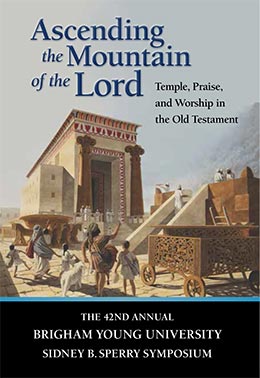Gestures of Praise: Lifting and Spreading the Hands in Biblical Prayer
David M. Calabro
David M. Calabro, “Gestures of Praise: Lifting and Spreading the Hands in Biblical Prayer,” in Ascending the Mountain of the Lord: Temple, Praise, and Worship in the Old Testament (2013 Sperry Symposium), ed. Jeffrey R. Chadwick, Matthew J. Grey, and David Rolph Seely (Provo, UT: Religious Studies Center, Brigham Young University; Salt Lake City: Deseret Book, 2013), 105–21.
David Calabro is a graduate student at the University of Chicago.
Prayer, including praise as well as supplication, tends to be understood as the offering up of words that are enunciated and heard. [1] However, prayer also has an important visual component, especially in the context of the temple, where ritual actions are a focus. [2] The quintessential type of gesture associated with prayer in the ancient world was the lifting of the hands, a visual sign that accompanied verbal expressions of praise and entreaty. [3]
The ancient Israelite gesture of raising both hands in praise or supplication is mentioned in twenty-four scriptural passages, of which twenty-two are from the Old Testament, one is from the New Testament, and one is from the Book of Mormon. [4] Similar references are also found in a small group of inscriptions from cultures closely related to ancient Israel (two Ugaritic and two Aramaic). [5] In addition, art from the ancient Levant bears witness to this gesture (see figs. 1–4 and discussion below). However, scholars who have studied the gesture based on the biblical text have tended either to rely on comparisons with the more distant cultures of Mesopotamia and Egypt or to ignore the evidence from art, leading to a distorted picture of what the gesture looked like. This is important because, in some cases, the precise meaning of the gesture depends on its apperance. For example, Mayer Gruber, based on analysis of biblical and Mesopotamian textual sources and perhaps influenced by Mesopotamian art, suggests that the gesture symbolizes a request for one’s empty hands to be filled, which assumes that the hands are raised with the palms upward. [6] At the same time, those who have commented on this gesture as it appears in Levantine art have generally given only cursory attention to the meaning of the gesture, as if the meaning is obvious and not worthy of in-depth study. An example of this kind of cursory interpretation is found in James Pritchard’s description of a relief on a sarcophagus from ancient Byblos: “The last four figures merely salute the king with upraised and out-turned hands.” [7]
My purpose in this study is to present the evidence for this gesture in the literature and art of the biblical world, combining the textual and artistic sources to establish the form and then the meaning of this gesture. I will begin by reviewing the examples of this gesture: first those from the biblical passages, then those from the inscriptions, and finally those from the artistic sources. Along the way, I will explain what these examples tell us about the gesture’s form. I will then discuss the gesture’s meaning, including how raising the hands in prayer may relate to other ritual actions that were performed in the same context.
Biblical Instances of Raising Both Hands in Prayer
Six Hebrew idioms are used in the Old Testament to describe the gesture of raising both hands in prayer. One of these is nāśāʾ yādayim, “lift up the hands,” which is used twice in the Psalms:
Hear the voice of my supplications, when I cry unto thee, when I lift up my hands toward thy holy oracle. (Psalm 28:2; emphasis added in scriptures quoted) [8]
Lift up your hands in the sanctuary, and bless the Lord. (Psalm 134:2)
An additional example of this idiom is found in the book of Habakkuk:
The mountains saw thee, and they trembled: the overflowing of the water passed by: the deep uttered his voice, and lifted up his hands on high. (Habakkuk 3:10)
The Hebrew text of the passage including Habbakuk 3:10 contains many problems, and scholars differ as to whether it was the deep or the sun (mentioned in the following verse) that was originally described as lifting up its hands, or whether an entirely different idiom was originally used. [9] In any case, the text as it now stands seems to describe the personified deep raising its “hands” (perhaps referring to waves) in praising God.
The second idiom used for this gesture is nāśāʾ kappayim. This idiom is also translated as “lift up the hands” in most English translations. [10]
Let my prayer be set forth before thee as incense; and the lifting up of my hands as the evening sacrifice. (Psalm 141:2)
Let us lift up our heart with our hands unto God in the heavens. (Lamentations 3:41) [11]
A third idiom, pāraś kappayim, means “spread or stretch out the hands.” This is the most common Hebrew idiom used for the raising of both hands in worship, and it is found in many biblical books, including the historical books:
And Moses said unto him, As soon as I am gone out of the city, I will spread abroad my hands unto the Lord; and the thunder shall cease, neither shall there be any more hail; that thou mayest know how that the earth is the Lord’s. . . . And Moses went out of the city from Pharaoh, and spread abroad his hands unto the Lord: and the thunders and hail ceased, and the rain was not poured upon the earth. (Exodus 9:29, 33)
Arise, cry out in the night: in the beginning of the watches pour out thine heart like water before the face of the Lord: lift up thy hands toward him for the life of thy young children, that faint for hunger in the top of every street. (Lamentations 2:19)
And Solomon stood before the altar of the Lord in the presence of all the congregation of Israel, and spread forth his hands toward heaven: . . . And it was so, that when Solomon had made an end of praying all this prayer and supplication unto the Lord, he arose from before the altar of the Lord, from kneeling on his knees with his hands spread up to heaven. (1 Kings 8:22, 54)
What prayer and supplication soever be made by any man, or by all thy people Israel, which shall know every man the plague of his own heart, and spread forth his hands toward this house: then hear thou in heaven thy dwelling place, and forgive, and do, and give to every man according to his ways, whose heart thou knowest. (1 Kings 8:38–39) [12]
The fourth idiom is pēraś (bə)yādayim “spread or stretch forth the hands.” This idiom occurs once in Psalms and once in Lamentations:
I stretch forth my hands unto thee: my soul thirsteth after thee, as a thirsty land. (Psalm 143:6)
Zion spreadeth forth her hands, and there is none to comfort her: the Lord hath commanded concerning Jacob, that his adversaries should be round about him: Jerusalem is as a menstruous woman among them. (Lamentations 1:17)
The idiom pēraś (bə)yādayim is also used in Isaiah 25 to describe quite a different action, namely the strokes of a swimmer. However, in using this figure of a swimmer, the prophet may also be making an allusion to raising the hands in worship:
For in this mountain shall the hand of the Lord rest, and Moab shall be trodden down under him, even as straw is trodden down for the dunghill. And he shall spread forth his hands in the midst of them, as he that swimmeth spreadeth forth his hands to swim: and he shall bring down their pride together with the spoils of their hands. (Isaiah 25:10–11)
The setting in which personified Moab will “spread forth his hands” is “this mountain,” referring to the mountain of the Lord (that is, the temple). It is likely that a double meaning of the gesture is intended: Moab, as he is being trodden down in the temple, will “spread forth his hands” in urgent prayer like that of the Psalmist in Psalm 143:6 and that of personified Zion in Lamentations 1:17, and the motions of his hands will be so desperate that they will be comparable to a swimmer’s strokes.
The idiom pēraś kappayim, which also means “spread forth the hands,” occurs twice in the prophetic books:
And when ye spread forth your hands, I will hide mine eyes from you: yea, when ye make many prayers, I will not hear: your hands are full of blood. (Isaiah 1:15)
For I have heard a voice as of a woman in travail, and the anguish as of her that bringeth forth her first child, the voice of the daughter of Zion, that bewaileth herself, that spreadeth her hands, saying, Woe is me now! for my soul is wearied because of murderers. (Jeremiah 4:31)
Finally, the phrase mōʿal yādayim “lifting up hands” is used once in the description of a prayer in the book of Nehemiah:
And Ezra blessed the Lord, the great God. And all the people answered, Amen, Amen, with lifting up their hands: and they bowed their heads, and worshipped the Lord with their faces to the ground. (Nehemiah 8:6)
The gesture of stretching forth or lifting up the hands, while most frequently found in the Old Testament, is also mentioned once in the Book of Mormon and once in the New Testament. In the Book of Mormon, this ancient Israelite gesture is part of the apostate worship practices of the Zoramites, although it is not stated whether the gesture itself was regarded as inappropriate:
Therefore, whosoever desired to worship must go forth and stand upon the top thereof, and stretch forth his hands towards heaven, and cry with a loud voice, saying: Holy, holy God. (Alma 31:14–15)
A statement in Paul’s letter to Timothy shows that this gesture was known among members of the Church in New Testament times:
I will therefore that men pray every where, lifting up holy hands, without wrath and doubting. (1 Timothy 2:8)
The Greek phrase used for the gesture in this verse is cheiras epairō “lift up the hands,” which is a phrase used in the Septuagint (the Greek translation of the Old Testament) to translate the Hebrew nāśāʾ yādayim. [13] Many ancient Jewish and early Christian sources also mention raising the hands in the context of worship. [14] Thus, when Paul expresses the wish “that men pray every where, lifting up holy hands,” he is speaking of a common Jewish and Christian practice with very ancient roots; Paul is not wishing for a new practice, but for its faithful observance and the sanctification of those who participate in it.
One scholar, Mayer Gruber, has suggested that two different prayer gestures are referred to in the Bible: a generic gesture of worship indicated by the verb nāśāʾ “lift up,” and a gesture of supplication indicated by the verb pāraś/
From the passages quoted above, we can gather some clues as to the form of the raised-hand gesture. For example, the verb nāśāʾ “raise” indicates that the hands are held high, perhaps at the level of the face or higher. Some passages refer to lifting or spreading the hands “to heaven,” “to God in heaven,” or “on high” (see 1 Kings 8:22, 54; Lamentations 3:41; Habakkuk 3:10; Alma 31:14–15); these passages seem to describe instances in which the hands are held especially high. In other cases, the target of the gesture appears to be roughly on the same level as the person performing it, such as when the hands are raised to the temple or to the Holy of Holies (see 1 Kings 8:38–39; Psalm 28:2). The reference to the swimmer’s strokes in Isaiah 25:10–11, if this does indeed allude to the prayer gesture, would imply that the gesture could involve some motion of the arms comparable to swimming (such as, perhaps, raising the hands and then lowering them). Also, the phrase spread forth the hands implies that the hands are held apart from each other, held open, or both.
The Raised-Hand Prayer Gesture in Ancient Inscriptions
A small handful of inscriptions from the area around ancient Israel mention a gesture that is identical or similar to that described in the biblical passages quoted above. Two of these inscriptions come from Ugarit, a city on the Mediterranean coast north of Israel that was destroyed in about 1185 BC. The first of these recounts instructions given by the god El to the hero Kirta, telling him how to approach and entreat the god Baal; the text then describes Kirta carrying out the instructions:
Ascend to the top of the tower, mount the shoulder of the wall. Lift up your hands to heaven, sacrifice to the Bull, your father El. Bring down Baal with your sacrifice, the son of Dagon with your prey. . . . He ascended to the top of the tower, he mounted the shoulder of the wall. He lifted up his hands to heaven, he sacrificed to the Bull, his father El. He brought down Baal with his sacrifice, the son of Dagon with his prey. [16]
The second Ugaritic inscription describes a ritual to be carried out at the time of vintage. As part of the ritual, the king is to offer a prayer:
When the sun rises, the king will be free of cultic obligations. . . . You shall take him back to [the palace]. [17] When he is there, he shall lift up his hands to heaven. [18]
The Ugaritic idiom used in both of these inscriptions is našaʾa yadêmi “lift up the hands,” which is cognate with the Hebrew nāśāʾ yādayim.
Two Aramaic inscriptions also refer to a gesture of raising the hands in worship. The first is from a stela dating to ca. 780 BC; it records a battle in which the king of Hamath, named Zakkur, lifted up his hands in prayer to the god Baal:
All these kings laid siege to Hadhrak. They raised a wall higher than the wall of Hadhrak, they dug a ditch deeper than its ditch. I lifted up my hands to Baal-shemayn. Baal-shemayn answered me, Baal-shemayn spoke to me through seers and through diviners. [19]
The other Aramaic example comes from a papyrus that contains several Aramaic texts written in Demotic Egyptian characters and was probably composed in Egypt around 300 BC. One of these texts makes reference to a widow to whom God has granted blessings:
Lord, God who judges the orphan, the widow who raised her hands towards you will straightway receive good tidings and will laugh; behold, she raised her hands, will straightway receive good tidings, and will laugh. (pAmherst 63 ix 17–19) [20]
The idiom used in both of these instances is nəśāʾ yədayn “lift up the hands,” which is cognate with the Hebrew nāśāʾ yādayim and the Ugaritic našaʾa yadêmi.
These inscriptions confirm that the gesture of lifting the hands in prayer was not unique to Israelite scripture but was part of a cultural heritage that was shared between Israel and surrounding peoples. As in the scriptural passages quoted above, the gesture as described in the inscriptions accompanies various kinds of prayer, including ritual prayer as well as spontaneous supplication. The inscriptions, like the scriptural passages, also sometimes indicate the height of the gesture with the terms “lift up” and “to heaven.” Many similar examples from elsewhere in the Near East could be added, showing that this cultural heritage extends beyond the area occupied by Israel’s closest neighbors. Some of these other examples will be touched on below.
The Raised-Hand Prayer Gesture in Ancient Levantine Art
When we survey the art of the ancient Levant (the area adjacent to the eastern Mediterranean, including the land of Israel) in search of a gesture of raising both hands in the context of prayer, we find one very prominent match: the raising of both hands to about the level of the mouth (sometimes higher or lower, depending on the locations of the one performing the gesture and of the gesture’s target), the palms slightly concave and facing outward. The gesture is performed kneeling or standing. This gesture is found depicted on ivory carvings, stone reliefs, stamp seals, and other art pieces from the Levant; it is also shown in Egyptian scenes showing Levantine people in an attitude of praise and supplication.
The number of relevant art pieces from the Levant is great, and it is possible to provide only a few examples and minimal discussion here. Figures 1–4 show a stela from Balu‘ah in Jordan (ca. 1200 BC), a carved ivory furniture panel from Ugarit (ca. 1350 BC), a carved ivory of Phoenician manufacture found at the Assyrian fortress of Nimrud (ca. 750 BC), and a Phoenician or Hebrew stamp seal (ca. 750 BC), respectively. Each of the examples is consistent with the idea that the gesture is one of prayer (defined in the introduction above as praise and supplication). Figure 3, for example, shows the person performing the gesture directly before a god, and figure 4 shows the two gesturing figures flanking a sacred scarab motif.
1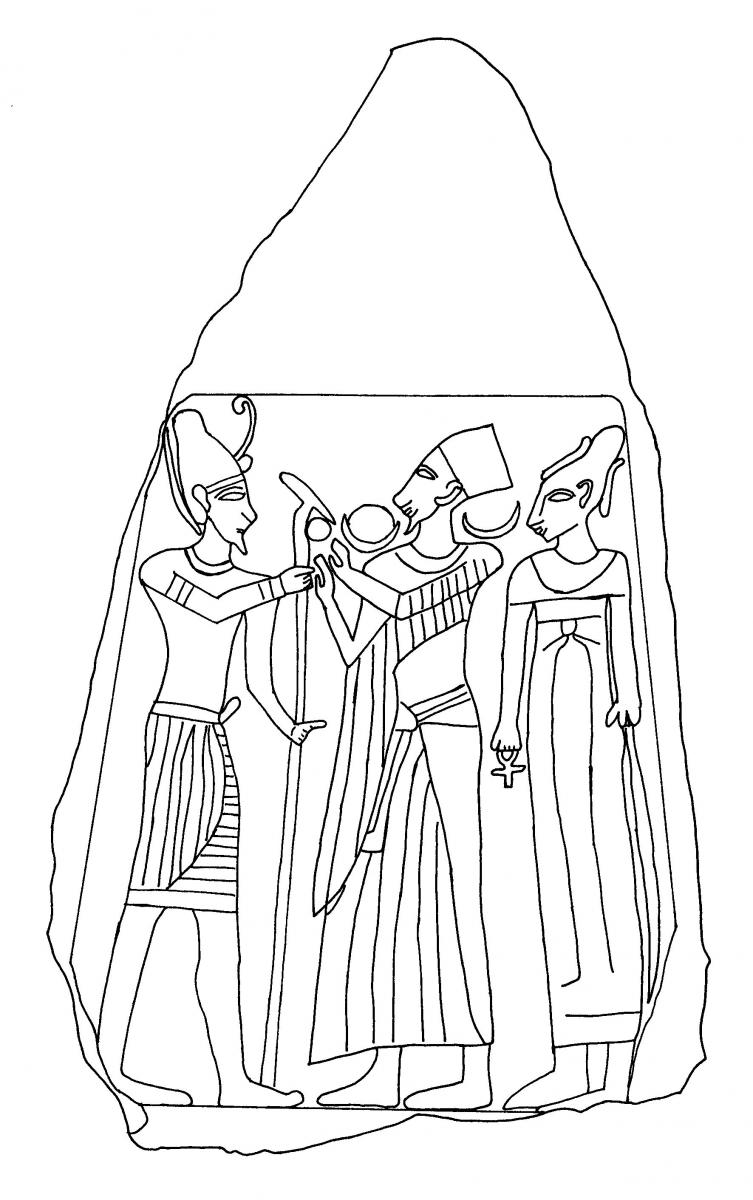 2
2

3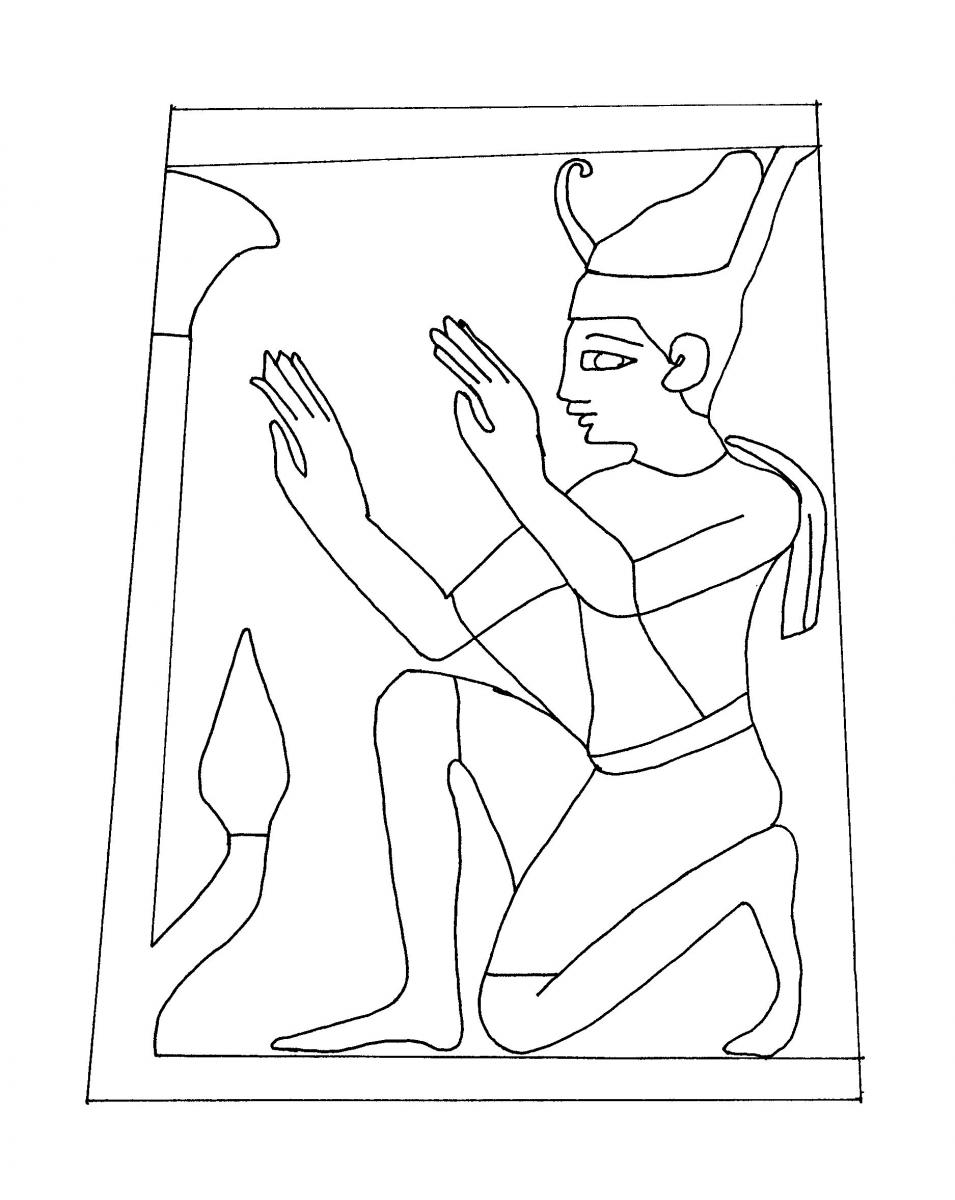 4
4
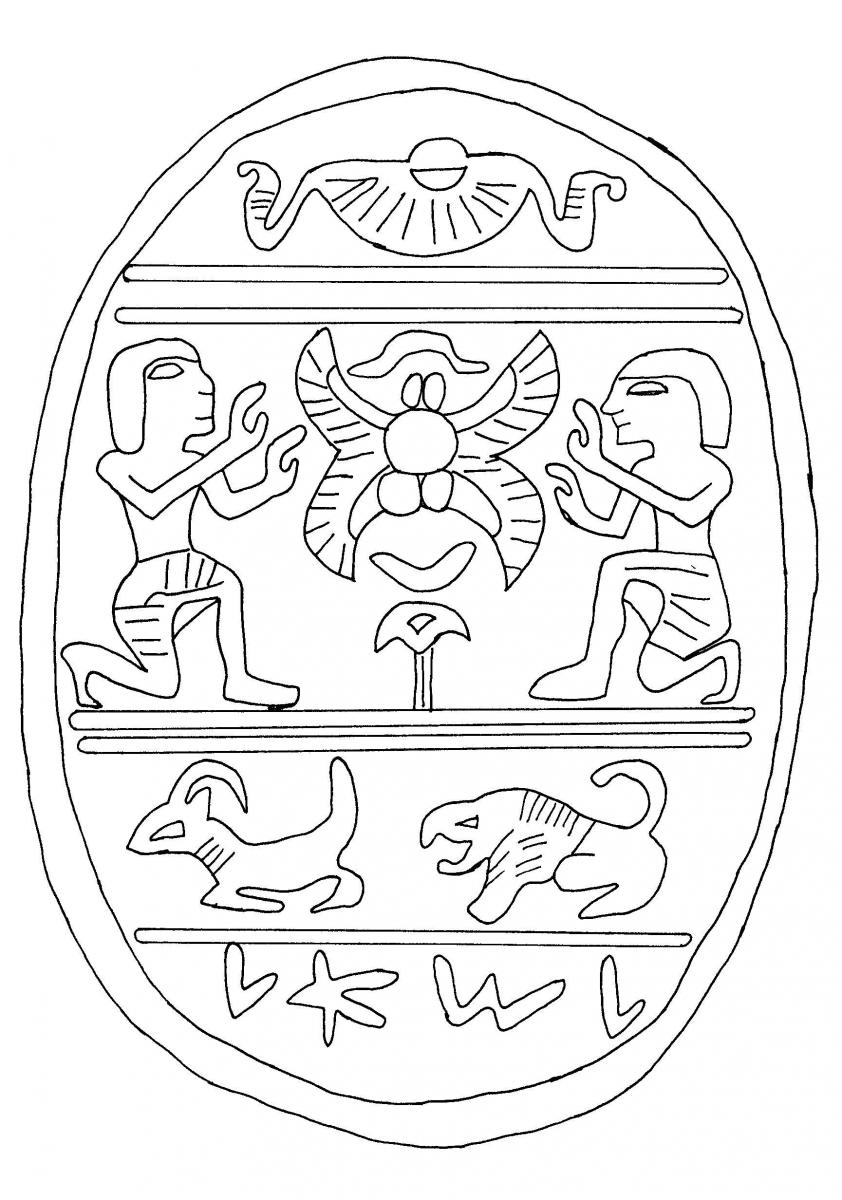
Figures 1–4. Balu‘ah stela; carved ivory panel from Ugarit; carved ivory panel from Nimrud; Hebrew or Phoenician stamp seal. Figure 1 redrawn from ANEP, 167 (no. 488). Figure 2 redrawn from Robert du Mesnil du Buisson, “Les ivoires du palais royal de Ras Shamra, du Musée de Damas,” in Nouvelles études sur les dieux et les mythes de Canaan (Leiden: Brill, 1973), pl. 11. Figure 3 redrawn from Georgina Herrmann, Ivories from Room SW37 Fort Shalmaneser (London: The British School of Archaeology in Iraq, 1986), pl. 2 (no. 12), bottom right portion reconstructed based on similar ivories. Figure 4 redrawn from Nahman Avigad and Benjamin Sass, Corpus of West Semitic Stamp Seals (Jerusalem: Israel Exploration Society, 1997), 445 (no. 1175). All drawings herein are by David Calabro.
Further examples of this gesture can be found in Egyptian representations of Semitic people addressing the pharaoh. A painting from the tomb of Menkheperresonb in Thebes (ca. 1450 BC), for example, shows a group of non-Egyptians (mostly Levantine Semitic people) approaching the pharaoh with gifts, at the same time supplicating him for “the breath of life” (fig. 5). The first one prostrates himself, while the second kneels and raises both hands in the prayer gesture, and the next two approach with offerings of a child and a drinking vessel in the shape of an animal’s head. This example shows the gesture as one stage of an elaborate ritual performed as a means of approaching the presence of the pharaoh. Since ancient Egyptians and tributary peoples regarded the pharaoh as a god, this example is relevant to understanding how Semitic people from the Levant used the gesture in the worship of their gods, including the Hebrew God, Jehovah.
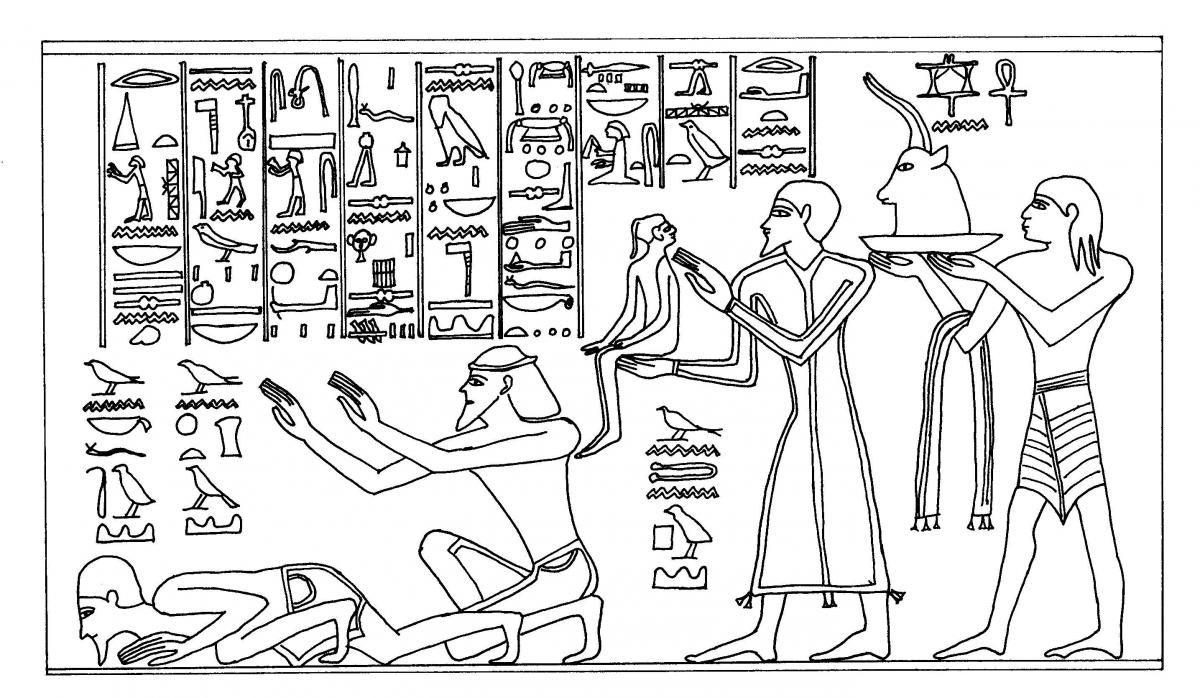
Figure 5. Painting from tomb of Menkheperresonb. Redrawn from ANEP, 15 (no. 45). The hieroglyphic inscription at the top reads: “Giving of praise to the Lord of the Two Lands, prostration to the beautiful god by the chiefs of every land, as they pay homage to the might of his majesty, bringing on their backs some of every product of the god’s land—silver, gold, lapis lazuli, turquoise, and every costly gemstone, in hopes that the breath of life might be granted them.”
An Egyptian relief from the tomb of Horemheb in Saqqara (ca. 1320 BC) shows a group of non-Egyptians (including some Semitic people) who are putting up a petition for help to the pharaoh (fig. 6). Some prostrate themselves with their arms fully extended, while others spread their arms wide. In all cases, however, the gesture is essentially the same, the hands raised with the palms facing outward. This example illustrates the different varieties of this gesture.
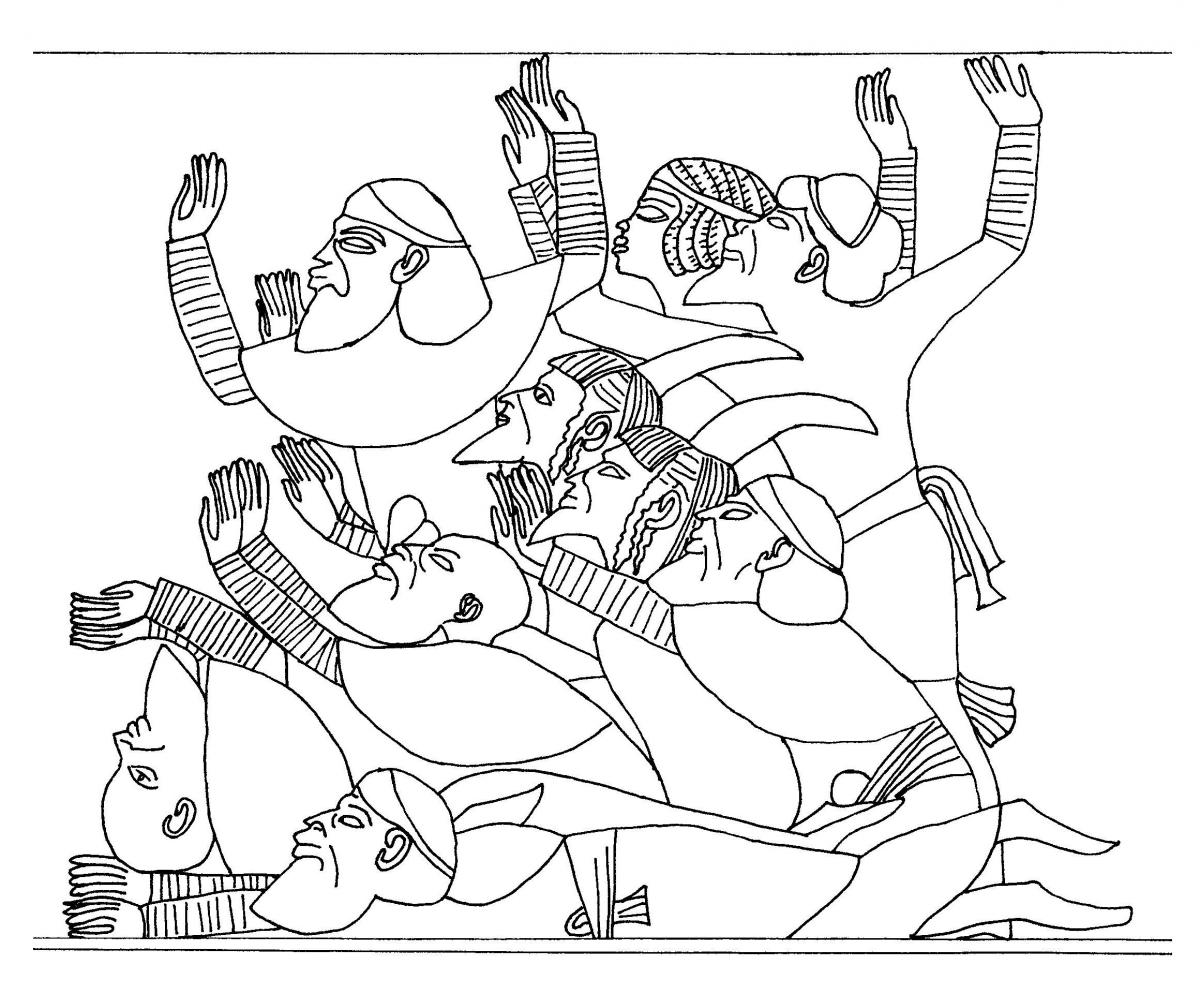
Figure 6. Relief from the tomb of Horemheb, Memphis. Redrawn from ANEP, 2 (no. 5).
These illustrations show that the prayer gesture essentially consisted of raising both hands with the palms facing outward. There was also a dynamic element, however, in the degree to which the hands were extended upward: the hands were held sometimes at the level of the face (as in figs. 2 and 3) and sometimes high above the head (as in fig. 4). The latter form of the gesture provides a suitable comparison for those textual passages that use the phrases “to heaven,” “to God in heaven,” or “on high” to describe the hands being held up high. The one physical aspect of this gesture that is not represented in art, which can only depict moments of action frozen in time, is the movement of the hands alluded to by Isaiah 25:10–11.
Gestures other than the lifting of both hands with the palms facing outward occur in Mesopotamian and Egyptian art in contexts that could be equated with prayer. Among these other gestures are the raising of one or both hands with the palm inward, the raising of one finger to the mouth, and the extending of the hands to the sides with the palms upward. [21] However, while comparisons with the closely related cultures in Mesopotamia and Egypt are often very informative, it must be emphasized that Hebrew culture is Levantine, not Mesopotamian or Egyptian. Some of these other prayer gestures may be frequently attested in Mesopotamia or Egypt, but they are rare or nonexistent in native Levantine sources from the biblical period. The relatively high number of examples of the palm-out gesture in Levantine sources and the certainty of its analysis as a prayer gesture based on context make this the most logical match for the biblical prayer gesture.
Being able to match the biblical descriptions of this gesture with ancient Near Eastern depictions is useful because it allows readers of the Bible to picture what is going on in the biblical passages. Matching these two sources also helps readers to understand the symbolism of the gesture, which I will now discuss.
The Meaning of the Raised-Hand Prayer Gesture
What is the meaning of raising both hands in prayer? Many answers to this question have been suggested. According to Gruber, as we have seen, there are two different gestures with different meanings in the textual sources. One of these gestures (denoted by the verb nāśāʾ “lift up”) is a way of pointing to God’s abode in heaven, while the other (denoted by pāraś/
Othmar Keel, a specialist in ancient Near Eastern art, suggests that the gesture was originally a response to coming into the holy presence of a deity: throwing up the hands to protect oneself and to ward off the potentially dangerous power of the divine being. [23] This suggestion would have interesting implications for a number of the textual passages discussed above. For example, in Isaiah 1:15, there could be irony in God’s statement: “And when ye spread forth your hands, I will hide mine eyes from you” (emphasis added). However, this interpretation is not very well supported by the Ugaritic narrative of Kirta and the Aramaic inscription of Zakkur, in which the gesture is performed before and not after the god’s response; it seems that in these passages and elsewhere, the gesture’s purpose is to invite rather than react to a manifestation of the god.
Other possibilities for the interpretation of this gesture are perfectly plausible in light of the evidence from texts and art. These include the following: (1) The gesture has the purpose of exposing the hands and heart to divine view, showing that one is pure and therefore qualified to be in God’s presence. [24] This suggestion is strongly supported by Isaiah 1:15, in which the gesture fails because the supplicants’ “hands are full of blood.” (2) A related possibility is that the gesture expresses surrender, displaying the hands empty of weapons and simultaneously exposing the vital organs. (3) The gesture has the purpose of attracting God’s attention. [25] (4) The gesture expresses a desire for contact with God. [26] (5) The gesture symbolizes life, and performing it in the context of prayer is equivalent to petitioning God to grant life. [27] (6) The gesture marks the relationship between the one performing it and the target, asserting that the former is lowly with respect to the latter and is at the latter’s service. These six interpretations are not mutually exclusive; in fact, it is not out of the question that all of these interpretations of the raised-hand gesture coexisted even in ancient times.
So far, I have focused on the meaning of the raised-hand gesture as an isolated action, independent of other actions or of the prayer ritual as a whole. An additional facet of this gesture’s meaning is how it functioned in concert with other gestures as part of a larger ritual. Combining textual and artistic sources gives us the opportunity to explore this facet of the prayer gesture from a fresh perspective. For example, the fact that examples in art show the gesture being performed both while standing and while kneeling raises the possibility that a prayer ritual would include both standing and kneeling in sequence. This may have taken the form of a repeated cycle of actions similar to Muslim prayer, which includes standing, raising the hands, clasping the hands in front of the torso, and prostrating oneself, all performed while remaining in one spot. Nehemiah 8:5–6 would support the idea that such a cycle existed in ancient Israelite prayer after the Babylonian captivity. At the reading of the “book of the law,” the people first stand up, then they lift up their hands while saying “Amen, amen,” then they kneel and finally prostrate themselves to the earth. After these actions, they apparently stand again (see verse 7).
The prayer gesture of raising the hands may also have been part of a series of “gestures of approach” performed as one drew near to the presence of deity. [28] In Psalm 63, in the explicit context of seeking God in the temple (verses 1–2), the Psalmist first mentions lifting up his hands (verse 4); then he mentions rejoicing “in the shadow of [God’s] wings,” perhaps alluding to an embrace (verse 7); and finally he mentions clasping God’s right hand (verse 8). While these actions may have been understood metaphorically, it is also possible that they were part of a concrete ritual in which a human priest represented the Lord by proxy, as Matthew Brown has suggested. [29] The Ugaritic Kirta epic describes a series of ritual actions that includes washing the hands, putting on red pigment, climbing atop a wall, raising the hands, and offering sacrifice; the progression is upward, and the god responds by coming down to meet Kirta. The tomb painting of Menkheperresonb (fig. 2 above) also shows a progression of gestures as people approach the presence of the pharaoh. The sequence includes presenting a gift with one hand while raising the other, raising both hands while kneeling, and finally prostrating oneself.
This exploration of the gesture associated with prayer in the biblical world should help us to appreciate how ancient Israelites understood prayer. The gesture is different from those typically used for private prayer by Latter-day Saints and other Christians today, such as the folding of the arms across the chest or the clasping of the hands in front of the chest or face. Nevertheless, the ancient raising and spreading of the hands may express concepts of prayer with which we can identify, such as God’s holiness, his knowledge of our moral state and of our private thoughts, submission to his will, and the desire to approach and achieve contact with him (see the possible interpretations of this gesture as discussed above). The characteristics of this gesture are in harmony with the Psalmist’s confidence and intense desire to approach God as expressed in Psalm 26:
Judge me, O Lord; for I have walked in mine integrity: I have trusted also in the Lord; therefore I shall not slide. Examine me, O Lord, and prove me; try my reins and my heart. For thy loving kindness is before mine eyes: and I have walked in thy truth. (vv. 1–3)
My discussion about the context and form of the raised-hand prayer gesture thus helps to clarify some of its possible meanings. Matching textual descriptions with pictorial representations makes it possible to more effectively evaluate how accurately an interpretation fits the gesture as it was originally performed. It also reveals ways in which it may have been used together with other gestures in ritual contexts. The saying that “a picture is worth a thousand words” holds true, but the value of both the picture and the words increases when the two are united.
Notes
[1] The verb pray, for example, is defined as “to utter a prayer or prayers” in The American Heritage College Dictionary, 3rd ed. (Boston and New York: Houghton Mifflin, 1993), 1075, definition 1. In some modern Romance languages, the word for “pray” is derived from Latin ōrāre “speak.”
[2] It is noteworthy that the Latter-day Saint Bible Dictionary entry on “prayer” contains a paragraph on the “attitude of prayer,” meaning the postures and gestures that accompany prayer.
[3] See the many illustrations from ancient art in Heinz Demisch, Erhobene Hände: Geschichte einer Gebärde in der bildenden Kunst (Stuttgart: Urachhaus, 1984), 107–68. The Egyptian hieroglyph standing for the word yau “praise” shows a man standing and raising both hands; see Alan Gardiner, Egyptian Grammar, 3rd ed. (Oxford: Griffith Institute, 1957), 445 (no. A30). Other gestures are also found in the context of prayer in ancient times. For example, Mesopotamian statuettes placed in temples as substitutes for petitioning individuals have both hands clasped in front of the torso, with the left hand inside the right hand. In Biblical Hebrew, the very common verb hištaḥăwâ “bow oneself” is used to signify “worship” (see, for example, Genesis 24:52; Exodus 20:4–5), the concept of worship being related to that of prayer. For the purposes of this paper, I distinguish between “gestures” involving primarily the movement of the hands and “postures” involving primarily the whole body; with this distinction, raising the hands is classified as a gesture, while bowing oneself is classified as a posture.
[4] Exodus 9:29, 33; 1 Kings 8:22, 38–39, 54; 2 Chronicles 6:12–13, 29–30; Ezra 9:5–6; Nehemiah 8:6; Job 11:13–15; Psalms 28:2; 44:20–21; 63:4; 119:48; 134:2; 141:2; 143:6; Isaiah 1:15; Jeremiah 4:31; Lamentations 1:17; 2:19; 3:41; Habakkuk 3:10; 1 Timothy 2:8; Alma 31:14–15.
[5] Manfried Dietrich, Oswald Loretz, and Joaquín Sanmartín, eds., Die keilalphabetischen Texte aus Ugarit (Neukirchen: Verlag Butzon & Bercker Kevalaer, 1976) (hereafter KTU), nos. 1.14 ii 21–26, iv 2–8; 1.41 50–55; H. Donner and W. Röllig, Kanaanäische und aramäische Inschriften (Wiesbaden: Otto Harrassowitz, 1976) (hereafter KAI), no. 202 A:9–12; pAmherst 63 ix 17–19. Each of these inscriptions is quoted and discussed below.
[6] Mayer Gruber, Aspects of Nonverbal Communication in the Ancient Near East (Rome: Biblical Institute Press, 1980), 35–37; cf. Stephen Langdon, “Gesture in Sumerian and Babylonian Prayer: A Study in Babylonian and Assyrian Archaeology,” Journal of the Royal Asiatic Society (October 1919): 542–43.
[7] James B. Pritchard, The Ancient Near East in Pictures Relating to the Old Testament (Princeton, NJ: Princeton University Press, 1954) (hereafter ANEP), 157, 302 (no. 456); emphasis added.
[8] The biblical quotations in this paper are drawn from the King James Version. I consider this translation to be generally accurate as far as the interpretation of gesture idioms is concerned.
[9] George Stonehouse, The Book of Habakkuk: Introduction, Translation, and Notes on the Hebrew Text (London: Rivingtons, 1911), 142, 239–42; Baruch Margulis, “The Psalm of Habakkuk: A Reconstruction and Interpretation,” Zeitschrift für die alttestamentliche Wissenschaft 82 (1970): 422–25; Yitzhak Avishur, Studies in Hebrew and Ugaritic Psalms (Jerusalem: Magnes Press, 1994), 181–83; W. F. Albright, “The Psalm of Habakkuk,” in Studies in Old Testament Prophecy, ed. H. H. Rowley (Edinburgh: T. & T. Clark, 1950), 11; Theodore Hiebert, God of My Victory: The Ancient Hymn in Habakkuk 3 (Atlanta: Scholars Press, 1986), 6, 30–31; Francis I. Andersen, Habakkuk, Anchor Bible 25 (New York: Doubleday, 2001), 312, 326–33.
[10] The word yād means “hand, forearm,” while kap means “palm, hand”; in the case of expresssions referring to the raising or spreading of the extremities, the parallel between expressions using yād and those using kap suggests that these two words should be translated identically as “hand” in these expressions.
[11] See also Psalms 63:4 (verse 5 in the Hebrew) and 119:48.
[12] Additional occurrences of this idiom are found in 2 Chronicles 6:12–13, 29–30, which is parallel to the passages from 1 Kings 8 quoted above, and in Ezra 9:5–6; Job 11:13–15; and Psalm 44:20–21 (verses 21–22 in the Hebrew).
[13] Psalm 134:2. The most common Greek phrase used to translate the Hebrew nāśāʾ yādayim and nāśāʾ kappayim is cheiras airō “lift the hands,” which is related to cheiras epairō. Different Greek phrases, including cheiras diapetannumi “spread out or open the hands,” are used to translate pāraś kappayim, pēraś (bə)yādayim, and pēraś kappayim. These various Greek phrases tell us little about the meaning of the Hebrew phrases or of the gesture itself, since they are basically direct, “wooden” translations of the Hebrew phrases.
[14] For an excellent survey of Jewish and early Christian sources mentioning the raising of both hands in prayer, see John A. Tvedtnes, “Temple Prayer in Ancient Times,” in The Temple in Time and Eternity, ed. Donald W. Parry and Stephen D. Ricks (Provo, UT: FARMS, 1999), 81–84.
[15] Gruber, Aspects of Nonverbal Communication, 35–37.
[16] The translations from Ugaritic, Aramaic, and Egyptian are my own unless otherwise indicated. (Kirta, KTU 1.14 ii 21–26, iv 2–8)
[17] Or, perhaps, “to [the temple].” The latter restoration is adopted by Baruch A. Levine, Jean-Michel de Tarragon, and Anne Robertson, “Ugaritic Rites for the Vintage (KTU 1.41//
[18] Rites for the Vintage, KTU 1.41 50–55
[19] Zakkur, KAI 202 A:9–12
[20] The translation given here of this very difficult text relies on that of S. P. Vleeming and J. W. Wesselius, Studies in Papyrus Amherst 63: Essays on the Aramaic Texts in Aramaic/
[21] Langdon, “Gesture in Sumerian and Babylonian Prayer”; Richard Neitzel Holzapfel, Dana M. Pike, and David Rolph Seely, Jehovah and the World of the Old Testament (Salt Lake City: Deseret Book, 2009), 231.
[22] Gruber, Aspects of Nonverbal Communication, 35–37.
[23] Othmar Keel, The Symbolism of the Biblical World: Ancient Near Eastern Iconography and the Book of Psalms (New York: Crossroad, 1985), 312–13.
[24] Tvedtnes, “Temple Prayer,” 81–84.
[25] In Isaiah 65:1–2, the phrase “spread out [the] hands,” though referring not to prayer but to an action carried out by God, is parallel to saying, “Behold me, behold me.”
[26] Keel, Symbolism of the Biblical World, 322; David Calabro, “‘When You Spread Your Palms, I Will Hide My Eyes’: The Symbolism of Body Gestures in Isaiah,” Studia Antiqua 9, no. 1 (Spring 2011): 30–31.
[27] Demisch, Erhobene Hände, 107–68.
[28] Mircea Eliade, Patterns in Comparative Religion, trans. Rosemary Sheed (New York: Sheed and Ward, 1958), 370–71; Hugh Nibley, “Temples Everywhere,” Insights 25, no. 1 (2005): 14.
[29] Matthew Brown, “The Handclasp, the Temple, and the King” (unpublished paper, August 2008). If this is to be taken as a metaphor, the imagery of praying with uplifted hands, embracing the god, and finally clasping his hand may still be rooted in earlier rituals in which physical contact occurred with a divine image or a human proxy.
